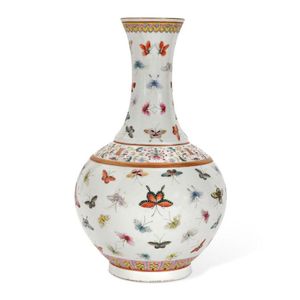Kinkozan Satsuma Vase with Procession Scene
You must be a subscriber, and be logged in to view price and dealer details.
Subscribe Now to view actual auction price for this item
When you subscribe, you have the option of setting the currency in which to display prices to $Au, $US, $NZ or Stg.
- Gilding - Gilding is a method of ornamentation whereby a thin sheet of gold metal is applied to items made of wood, leather, ceramics, glass and silver for decorative purposes.
For furniture including mirrors, the sheet of gold is usually applied over a coating of gesso. Gesso is a mixture of plaster of Paris and gypsum mixed with water and then applied to the carved wooden frames of mirrors and picture frames as a base for applying the gold leaf. After numerous coats of gesso have been applied, allowed to dry and then sanded a coat of "bole", a usually red coloured mixture of clay and glue is brushed on and allowed to dry, after which the gold leaf is applied. Over time parts of the gilding will rub off so the base colour can be seen. In water gilding, this was generally a blue colour, while in oil gilding, the under layer was often yellow. In Victorian times, gilders frequently used red as a pigment beneath the gold leaf.
Metal was often gilded by a process known as fire gilding. Gold mixed with mercury was applied and heated, causing the mercury to evaporate, the long-term effect of which was to kill or disable the craftsman or woman from mercury poisoning. The pursuit of beauty has claimed many victims, not the least of which were the artists who made those pieces so highly sought after today. - Earthenware - A basic ceramic material that is fired at a low temperature. Earthenware is the basis of almost all ancient, medieval, Middle Eastern and European painted ceramics. After firing, the colour is the colour of the clay when it is dug from the ground: buff, brown and red. It is not waterproof until glazed. Creamware is a type of earthenware covered with a transparent lead glaze. Majolica, faience and delft are also earthenware covered in an opaque white tin glaze.
This item has been included into following indexes:
- Japanese ceramics, factories and cities - Kinkozan 119
-
Japanese ceramics, item types
- double gourd vases 12
- other 2,591
- Satsuma (Japan), item type - other items 2,099
Visually similar items

A museum copy Qianlong porcelain vase, ovoid shape, decorated with birds on fruiting pomegranate boughs. Seal mark under the base. Height 40 cm

A 'famille-rose' 'butterfly' vase mark of Guangxu, the globular body rising to a trumpet neck, decorated in iron-red and 'famille-rose' enamels with numerous butterflies in flight, divided by a frieze of detached stylised lotus sprays and shou characters a

Chinese Meiping ceramic vase, red rust floral decoration on white ground. Height 2 cm

Peking carved glass vase (minor crack)
